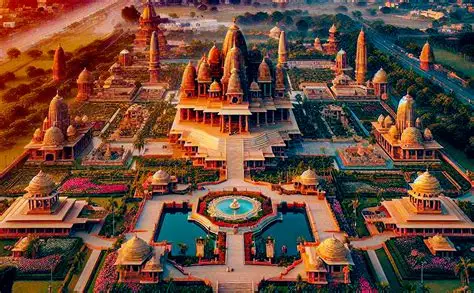From mythological marvels to spiritual sanctuaries, Ayodhya visiting places offer a timeless journey through devotion, heritage, and serenity. Ayodhya, nestled on the banks of the Sarayu River in Uttar Pradesh, is one of India’s most revered spiritual destinations. Known as the birthplace of Lord Rama, this ancient city is a cornerstone of Hindu mythology and a vibrant center of pilgrimage. The Ayodhya visiting places span centuries of devotion, architectural marvels, and cultural resonance—making it a must-visit for seekers, historians, and curious travelers alike.
🛕 1. Ram Janmabhoomi Temple
-
Significance: Believed to be the exact birthplace of Lord Rama.
-
Highlights:
-
Newly constructed grand temple with intricate carvings and spiritual ambiance.
-
Daily aartis and darshan draw thousands of devotees.
-
Surrounded by landscaped gardens and cultural exhibits.
-
-
Tip: Visit during early morning or evening aarti for a serene experience.
🏰 2. Hanuman Garhi Mandir
-
Significance: Dedicated to Lord Hanuman, protector of Ayodhya.
-
Highlights:
-
Fort-like structure with 76 steps leading to the shrine.
-
Idol of Hanuman in a seated posture with Ram and Lakshman.
-
Panoramic views of the city from the top.
-
-
Tip: A popular stop before visiting Ram Janmabhoomi.
🏡 3. Kanak Bhawan
-
Significance: Believed to be gifted to Sita by Queen Kaikeyi.
-
Highlights:
-
Ornate interiors with idols of Ram and Sita in gold attire.
-
Peaceful courtyard and devotional music.
-
A blend of Mughal and Rajput architecture.
-
-
Tip: Ideal for photography and quiet reflection.
🍽️ 4. Shri Sita Rasoi
-
Significance: Mythical kitchen of Goddess Sita.
-
Highlights:
-
Houses ancient kitchen utensils and idols of Ram’s brothers and their consorts.
-
Symbolizes domestic harmony and devotion.
-
-
Tip: Combine with a visit to Kanak Bhawan for a thematic experience.
🏯 5. Dashrath Bhavan
-
Significance: Royal residence of King Dashrath, father of Lord Rama.
-
Highlights:
-
Vibrant murals and devotional chants.
-
Hosts regular bhajan sessions and spiritual discourses.
-
-
Tip: Visit during festivals for cultural performances.
🌊 6. Ram Ki Paidi
-
Significance: Sacred ghats along the Sarayu River.
-
Highlights:
-
Ideal for ritual bathing and evening aarti.
-
Illuminated steps and serene river views.
-
Popular during Deepotsav and Kartik Purnima.
-
-
Tip: Sunset boat rides offer magical views.
🕌 7. Nageshwarnath Temple
-
Significance: Built by Kush, son of Lord Rama.
-
Highlights:
-
Dedicated to Lord Shiva.
-
Intricate carvings and spiritual ambiance.
-
-
Tip: Visit during Shivratri for special rituals.
🏞️ 8. Guptar Ghat
-
Significance: Believed to be the site of Lord Rama’s final departure from Earth.
-
Highlights:
-
Peaceful setting with temples and shrines.
-
Ideal for meditation and quiet reflection.
-
-
Tip: Less crowded than Ram Ki Paidi, perfect for solitude.
🕌 9. Gulab Bari
-
Significance: Mausoleum of Nawab Shuja-ud-Daula.
-
Highlights:
-
Mughal-style gardens and architecture.
-
Blend of Islamic and Awadhi heritage.
-
-
Tip: A unique contrast to Ayodhya’s predominantly Hindu landmarks.
🏛️ 10. Treta Ke Thakur
-
Significance: Houses idols believed to be installed by King Vikramaditya.
-
Highlights:
-
Ancient temple with black stone idols of Ram, Sita, Lakshman, Hanuman.
-
Open only on Ekadashi, attracting thousands of devotees.
-
-
Tip: Plan your visit around the lunar calendar.
🧘 11. Jain Shrines in Ayodhya
-
Significance: Birthplace of five Jain Tirthankaras.
-
Highlights:
-
Temples dedicated to Rishabhdev and other Tirthankaras.
-
Peaceful ambiance and intricate marble work.
-
-
Tip: Ideal for those exploring multi-faith heritage.
🎉 12. Ayodhya Deepotsav
-
Significance: Annual celebration of Lord Rama’s return to Ayodhya.
-
Highlights:
-
Millions of diyas lit across ghats and temples.
-
Cultural performances, laser shows, and processions.
-
-
Tip: Book accommodations early; the city gets packed.
🧭 Suggested Itinerary (3 Days / 2 Nights)
Day 1:
-
Morning: Ram Janmabhoomi, Hanuman Garhi
-
Afternoon: Kanak Bhawan, Sita Rasoi
-
Evening: Ram Ki Paidi aarti
Day 2:
-
Morning: Dashrath Bhavan, Nageshwarnath Temple
-
Afternoon: Guptar Ghat, Treta Ke Thakur
-
Evening: Gulab Bari and local market
Day 3:
-
Optional: Jain temples and nearby shrines
-
Departure
🛍️ What to Buy
-
Ayodhya-themed souvenirs: Miniature temples, diyas, Ramayana books.
-
Local crafts: Wooden toys, brass idols, handloom textiles.
-
Prasad & sweets: Pedas, laddoos, and temple offerings.
🏨 Where to Stay
-
Luxury: Ramayana Hotel, Clarks Inn Express
-
Mid-range: Hotel Ramprastha, Taraji Resort
-
Budget: Dharamshalas near Ram Janmabhoomi
🚗 Travel Tips
-
Best Time to Visit: October to March; Deepotsav in November is spectacular.
-
Local Transport: E-rickshaws and taxis are easily available.
-
Etiquette: Dress modestly, respect temple customs, and avoid littering.
-
Safety: Ayodhya is safe for tourists; stay hydrated and follow local guidelines.
Final Thought
Ayodhya visiting places offer a journey through devotion, mythology, and timeless heritage. Whether you're attending aarti at Ram Ki Paidi, exploring the grandeur of Ram Janmabhoomi, or soaking in the serenity of Guptar Ghat, Ayodhya promises a spiritual experience that lingers long after your visit.



